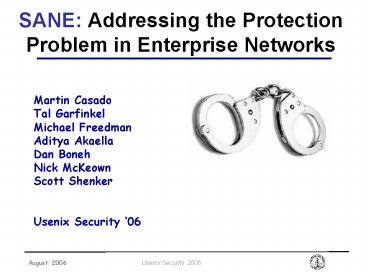SANE: Addressing the Protection Problem in Enterprise Networks - PowerPoint PPT Presentation
Title:
SANE: Addressing the Protection Problem in Enterprise Networks
Description:
Change a firewall rule, break security policy. Add a switch, break security policy ... Are you INSANE? August, 2006. Usenix Security 2006 ... – PowerPoint PPT presentation
Number of Views:60
Avg rating:3.0/5.0
Title: SANE: Addressing the Protection Problem in Enterprise Networks
1
SANE Addressing the Protection Problem in
Enterprise Networks
Martin Casado Tal Garfinkel Michael
Freedman Aditya Akaella Dan Boneh Nick
McKeown Scott Shenker Usenix Security 06
2
SANE
- SANE a proposal for a NAC (network access
control) architecture - Enterprise networks only
- Default off design
- Centralized policy management, distributed
policy enforcement.
3
LAN Policy Today
- Brittle
- Change a firewall rule, break security policy
- Add a switch, break security policy
- Many heavily trusted components (dhcp, DNS,
AD/LDAP ..) - Trade-off between security and diagnostics
(e.g. ICMP often turned off ..) - Confusing
- Hard to state meaningful policies
4
SANE(Secure Architecture for the Networked
Enterprise)
- Properties
- Policy declared centrally over high-level
principles - All network entities (hosts, switches, users) are
authenticated - Permissions checked per flow at central authority
- Access granted in the form of routes(capability
encrypted source route) - Doesnt reveal sender, packet path, topology
5
Provide Isolation Layer
Application
Transport
Introduce layer 2.5Isolation Layer
Network
Datalink
Physical
- Strictly defines connectivity
6
Action Sequence!
Publishmartin.friends.ambient-streamsallow tal,
sundar, aditya
Authenticatehi, Im tal, my password is
martin.friends.ambient-streams
Requestmartin.friends.ambient-streams
Authenticatehi, Im martin, my password is
1
2
1
4
4
3
3
2
4
1
7
Overview
- Send link state information to the DC
- Provide default connectivity to the DC
- Validate capabilities
- Forward packets base on capability
- Enforce revocations
- Publish services at the DC
- Specify access controls(export streams.ambient
allow tal) - Request access to services
- Use appropriate capability for each packet
Domain Controller
- Authenticates switches/end-hosts
- Established secret with each switch
- Contains network topology
- Hosts services (by name)
- Manages permission checking
- Creates and issues capabilities
Switches
End-Hosts
8
Bootstrapping
- How is connectivity to the DC provided?
- Initial MST construction
- How are keys established?
- Ike2 establishes symmetric key with DC
- How does the DC get the topology?
- DC aggregates topology after MST creation
9
Connectivity to the DC
- Switches construct spanning tree
- Rooted at DC
- Only advertise new path aftersuccessfully
authenticating - Provides basic datagram service to DC(switches
build capabilities as packets are forwarded to
the DC) - Switches dont learn topology(just neighbors)
10
Establishing Shared Keys
- Switches authenticate with DCand establish
symmetric key - Ike2 for key establishment
- All subsequent packets to DC protected by esp
header
11
Establishing Topology
- Switches generate neighbor listsduring MST
algorithm - Send encrypted neighbor-listto DC
- DC aggregates full topology
- Can verify false advertisements
- Can verify if duplicate or non-registeredswitches
on network - No switch knows full topology
12
Are you INSANE?
- Fault Tolerance
- Central control!
- Loss of adaptive routing!
- Revocation
13
Adaptive Routing
- On failure, end-hosts must refresh capabilities
- Timeouts to detect failures
- Can result in request storm at DC
- Issue multiple capabilities(hand out n of the k
shortest paths) - More switch level redundancy(doesnt undermine
security!) - Path load balancing(randomly choose one of the k
shortest paths)
14
Permission Check per Flow?
- Exists today, sort of .. (DNS)
- Permission check is fast
- Replicate DC
- Computationally (multiple servers)
- Topologically (multiple servers in multiple
places)
15
Revocation
- Request from DC
- Sent back along incoming path
- Switches maintain small CAMs
- If CAMs fill, switches generate new keys
- Too many revocations loose privileges
- Complexity is a result of stateless DC
16
Implementation
- Prototype system built in software(currently
working on the hardware) - Ran in 9 workstation network for a month
17
Capabilities
- Onion-encrypted source routes
- Encryption means, encrypt MAC
- Each layer using a secret key shared by the DC
and the switch - 10 hops 164 byte header
- Contain
- path information
- Expiration
- Unique ID
SW2
3
1
2
2
SW1
1
4
Esw1
1,4
MAC
CAP-ID
Expiration
3,2
MAC
2,1
MAC
Service port
MAC
Esw2
18
User Authentication
- DC creates route from itself to authentication
server - Use third-party mechanism for user
authentication - (e.g. radius)
- DC places itself on-route for all authentication
- Snoops protocol to determine if authentication
is successful - Identifies user by location networkidentifier
(e.g. MAC address)
Kerberos
DC
19
Actually .
- Routing and permission check can be decoupled
- Network functionality providedby DEs
- Permission check at DC,informs DE to set up
routewith optional constraints - DEs describe in 4D work(Albert Greenberg, Gisli
Hjalmtysson, David A. Maltz, Andy Myers,
Jennifer Rexford, Geoffrey Xie, Hong Yan, Jibin
Zhan, Hui Zhang )
20
Scalability
- DCs can be physically replicated
- Test - 8,000 IP addresses for 34 hours
- 47 million packets, 21,000 DNS requests, 150,000
TCP connections - Peak only 200 requests/sec on DC
- Test DC can handle 40x this traffic
- Link Failure
- Worst case only 2 requests/sec more
- Handful of DCs can handle tens of thousands of
end hosts
21
Conclusion
- Enterprise networks have different needs than the
Internet as a whole - Increased security to protect resources
- Centralized control
- SANE takes an extreme approach to security
- Provides minimum possible privileges to end users
- Gives attackers fewest possible attack vectors
- SANE is still practical
- Can be implemented with few modifications to
current networks - Scalable to networks with thousands of nodes































